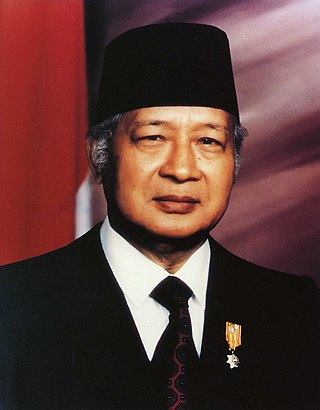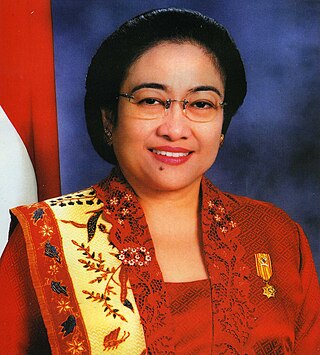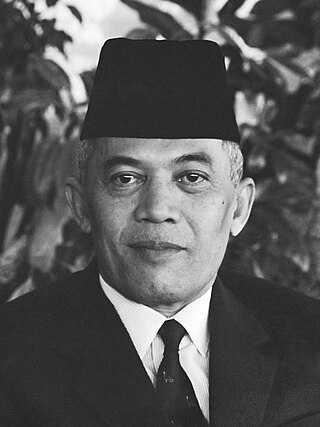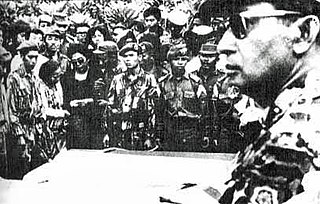
The politics of Indonesia take place in the framework of a presidential representative democratic republic whereby the President of Indonesia is both head of state and head of government and of a multi-party system. Executive power is exercised by the government. Legislative power is vested in both the government and the bicameral People's Consultative Assembly. The judiciary is independent of the executive and the legislature.

Suharto was an Indonesian military officer and politician, who served as the second and the longest serving president of Indonesia. Widely regarded as a military dictator by international observers, Suharto led Indonesia as an authoritarian regime from the fall of his predecessor Sukarno in 1967 until his resignation in 1998 following nationwide unrest. His 32-year dictatorship is considered one of the most brutal and corrupt of the 20th century.

Diah Permata Megawati Setiawati Sukarnoputri is an Indonesian politician who served as the fifth president of Indonesia from 2001 to 2004. She previously served as the eighth vice president from 1999 to 2001.

Abdul Haris Nasution was a high-ranking Indonesian general and politician. He served in the military during the Indonesian National Revolution and he remained in the military during the subsequent turmoil of the Parliamentary democracy and Guided Democracy. Following the fall of President Sukarno from power, he became the Speaker of the People's Consultative Assembly under President Suharto. Born into a Batak Muslim family, in the village of Hutapungkut, Dutch East Indies, he studied teaching and enrolled at a military academy in Bandung.

Adam Malik Batubara was an Indonesian politician, diplomat, and journalist, who served as the third vice president of Indonesia from 1978 until 1983, under President Suharto. Previously, he served in a number of diplomatic and governmental positions, including Speaker of the People's Consultative Assembly from 1977 to 1978, Speaker of the People's Representative Council from 1977 to 1978, Foreign Minister of Indonesia from 1966 until 1977, and president of the United Nations General Assembly from 1971 until 1972.

The term Government of the Republic of Indonesia can have a number of different meanings. At its widest, it can refer collectively to the three traditional branches of government – the executive branch, legislative branch and judicial branch. The term is also used colloquially to mean the executive and legislature together, as these are the branches of government responsible for day-to-day governance of the nation and lawmaking. At its narrowest, the term is used to refer to the executive branch in form of the Cabinet of Indonesia as this is the branch of government responsible for day-to-day governance.

Sri Sultan Hamengkubuwono IX (Hanacaraka: ꦯꦿꦶꦯꦸꦭ꧀ꦡꦟ꧀ꦲꦩꦼꦁꦑꦸꦨꦸꦮꦟ꧇꧙꧇, often abbreviated as HB IX was an Indonesian politician and Javanese royal who was the second vice president of Indonesia, the ninth sultan of Yogyakarta, and the first governor of the Special Region of Yogyakarta. Hamengkubuwono IX was also the chairman of the first National Scout Movement Quarter and was known as the Father of the Indonesian Scouts.

Gelora Bung Karno Sports Palace, formerly named Istora Senayan is an indoor sporting arena located in Gelora Bung Karno Sports Complex, Jakarta, Indonesia. The capacity of the arena after 2018 reopening is 7,166. This arena is usually used for badminton tournaments. Its maiden event was the 1961 Thomas Cup.

The New Order describes the regime of the second Indonesian President Suharto from his rise to power in 1966 until his resignation in 1998. Suharto coined the term upon his accession and used it to contrast his presidency with that of his predecessor Sukarno.

Indonesia's transition to the New Order in the mid-1960s ousted the country's first president, Sukarno, after 22 years in the position. One of the most tumultuous periods in the country's modern history, it was the commencement of Suharto's 31-year presidency.

The People's Consultative Assembly of the Republic of Indonesia is the legislative branch in Indonesia's political system. It is composed of the members of the House of Representatives (DPR) and the Regional Representative Council (DPD). Before 2004, and the amendments to the 1945 Constitution, the MPR was the highest governing body in Indonesia.

The Order of Eleventh March, commonly referred to by its syllabic abbreviation Supersemar, was a document signed by the Indonesian President Sukarno on 11 March 1966, giving army commander Lt. Gen. Suharto authority to take whatever measures he "deemed necessary" to restore order to the chaotic situation during the Indonesian mass killings of 1965–66. The abbreviation "Supersemar" is also a play on the name of Semar, the mystic and powerful figure who commonly appears in Javanese mythology including wayang puppet shows. The invocation of Semar was presumably intended to help draw on Javanese mythology to lend support to Suharto's legitimacy during the period of the transition of authority from Sukarno to Suharto.

The president of the Republic of Indonesia is the head of state and head of government of the Republic of Indonesia. The president leads the executive branch of the Indonesian government and is the commander-in-chief of Indonesian National Armed Forces and Indonesian National Police. Since 2004, the president and vice president are directly elected to a five-year term, once renewable, allowing for a maximum of 10 years in office.

The acting presidency of Suharto followed the transition to the New Order in which Army General Suharto assumed presidential powers to "restore" law and order following the now-disputed attempted coup which led to anti-communist purges. The term lasted from 12 March 1967 until 27 March 1968, when Suharto was officially inaugurated as the definitive President of Indonesia.

The Parliamentary Complex of Indonesia, also known as the MPR/DPR/DPD Building, is the seat of government for the Indonesian legislative branch of government, which consists of the People's Consultative Assembly (MPR), the People's Representative Council (DPR) and the Regional Representative Council (DPD).

Sidarto Danusubroto is an Indonesian politician and a retired police officer, who is serving as a member of Indonesia's Presidential Advisory Board. A member of the Indonesian Democratic Party of Struggle, he previously served as speaker of the People's Consultative Assembly, from 2013 until 2014, following the death of Taufiq Kiemas.

The Indonesian Muslims' Party, better known by the syllabic abbreviation Parmusi, was an Islamic political party in Indonesia which existed from 1968 until 1973. Founded as the legal successor to the Masyumi Party, it came fourth in the 1971 Indonesian legislative election, winning 5.36% of the vote and 24 seats in the People's Representative Council. In 1973, Parmusi was merged into the United Development Party.
The People's Consultative Assembly, the bicameral legislature of Indonesia, passed a series of resolutions of the People's Consultative Assembly or TAP MPR throughout the 1960s, to the very last issued in 2003.
















